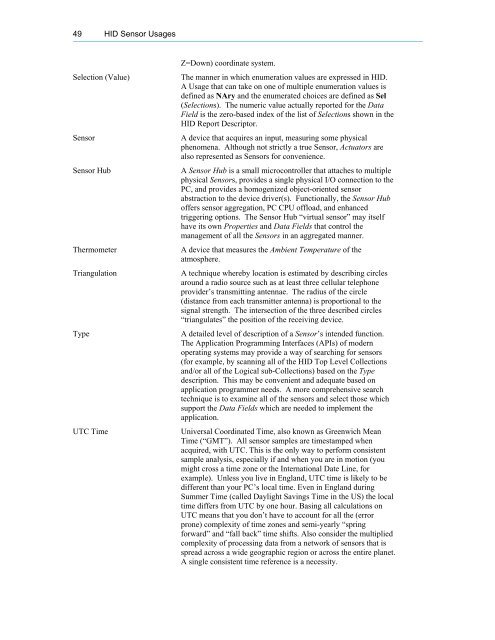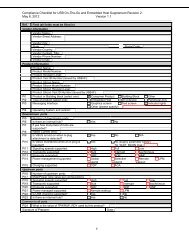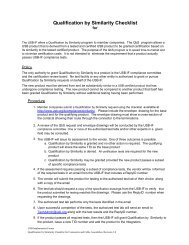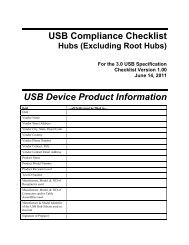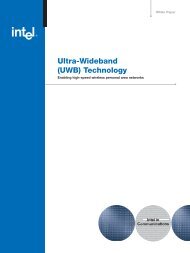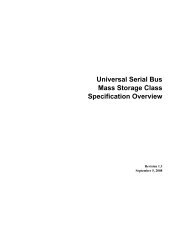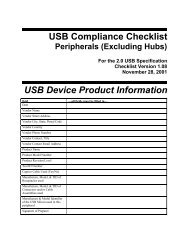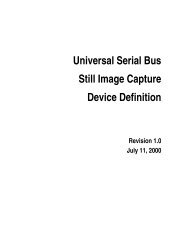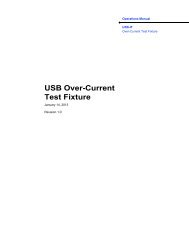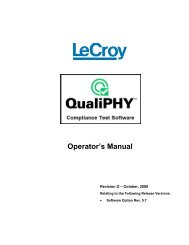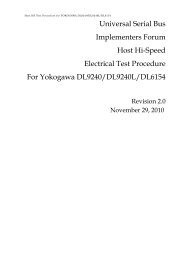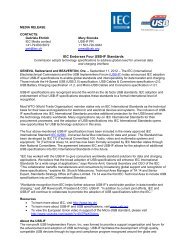You also want an ePaper? Increase the reach of your titles
YUMPU automatically turns print PDFs into web optimized ePapers that Google loves.
49 <strong>HID</strong> <strong>Sensor</strong> <strong>Usage</strong>s<br />
Z=Down) coordinate system.<br />
Selection (Value) The manner in which enumeration values are expressed in <strong>HID</strong>.<br />
A <strong>Usage</strong> that can take on one of multiple enumeration values is<br />
defined as NAry and the enumerated choices are defined as Sel<br />
(Selections). The numeric value actually reported for the Data<br />
Field is the zero-based index of the list of Selections shown in the<br />
<strong>HID</strong> Report Descriptor.<br />
<strong>Sensor</strong> A device that acquires an input, measuring some physical<br />
phenomena. Although not strictly a true <strong>Sensor</strong>, Actuators are<br />
also represented as <strong>Sensor</strong>s for convenience.<br />
<strong>Sensor</strong> Hub A <strong>Sensor</strong> Hub is a small microcontroller that attaches to multiple<br />
physical <strong>Sensor</strong>s, provides a single physical I/O connection to the<br />
PC, and provides a homogenized object-oriented sensor<br />
abstraction to the device driver(s). Functionally, the <strong>Sensor</strong> Hub<br />
offers sensor aggregation, PC CPU offload, and enhanced<br />
triggering options. The <strong>Sensor</strong> Hub “virtual sensor” may itself<br />
have its own Properties and Data Fields that control the<br />
management of all the <strong>Sensor</strong>s in an aggregated manner.<br />
Thermometer A device that measures the Ambient Temperature of the<br />
atmosphere.<br />
Triangulation A technique whereby location is estimated by describing circles<br />
around a radio source such as at least three cellular telephone<br />
provider’s transmitting antennae. The radius of the circle<br />
(distance from each transmitter antenna) is proportional to the<br />
signal strength. The intersection of the three described circles<br />
“triangulates” the position of the receiving device.<br />
Type A detailed level of description of a <strong>Sensor</strong>’s intended function.<br />
The Application Programming Interfaces (APIs) of modern<br />
operating systems may provide a way of searching for sensors<br />
(for example, by scanning all of the <strong>HID</strong> Top Level Collections<br />
and/or all of the Logical sub-Collections) based on the Type<br />
description. This may be convenient and adequate based on<br />
application programmer needs. A more comprehensive search<br />
technique is to examine all of the sensors and select those which<br />
support the Data Fields which are needed to implement the<br />
application.<br />
UTC Time Universal Coordinated Time, also known as Greenwich Mean<br />
Time (“GMT”). All sensor samples are timestamped when<br />
acquired, with UTC. This is the only way to perform consistent<br />
sample analysis, especially if and when you are in motion (you<br />
might cross a time zone or the International Date Line, for<br />
example). Unless you live in England, UTC time is likely to be<br />
different than your PC’s local time. Even in England during<br />
Summer Time (called Daylight Savings Time in the US) the local<br />
time differs from UTC by one hour. Basing all calculations on<br />
UTC means that you don’t have to account for all the (error<br />
prone) complexity of time zones and semi-yearly “spring<br />
forward” and “fall back” time shifts. Also consider the multiplied<br />
complexity of processing data from a network of sensors that is<br />
spread across a wide geographic region or across the entire planet.<br />
A single consistent time reference is a necessity.


